The historic Albee arch won’t be on the renovated convention center. Where should it go?
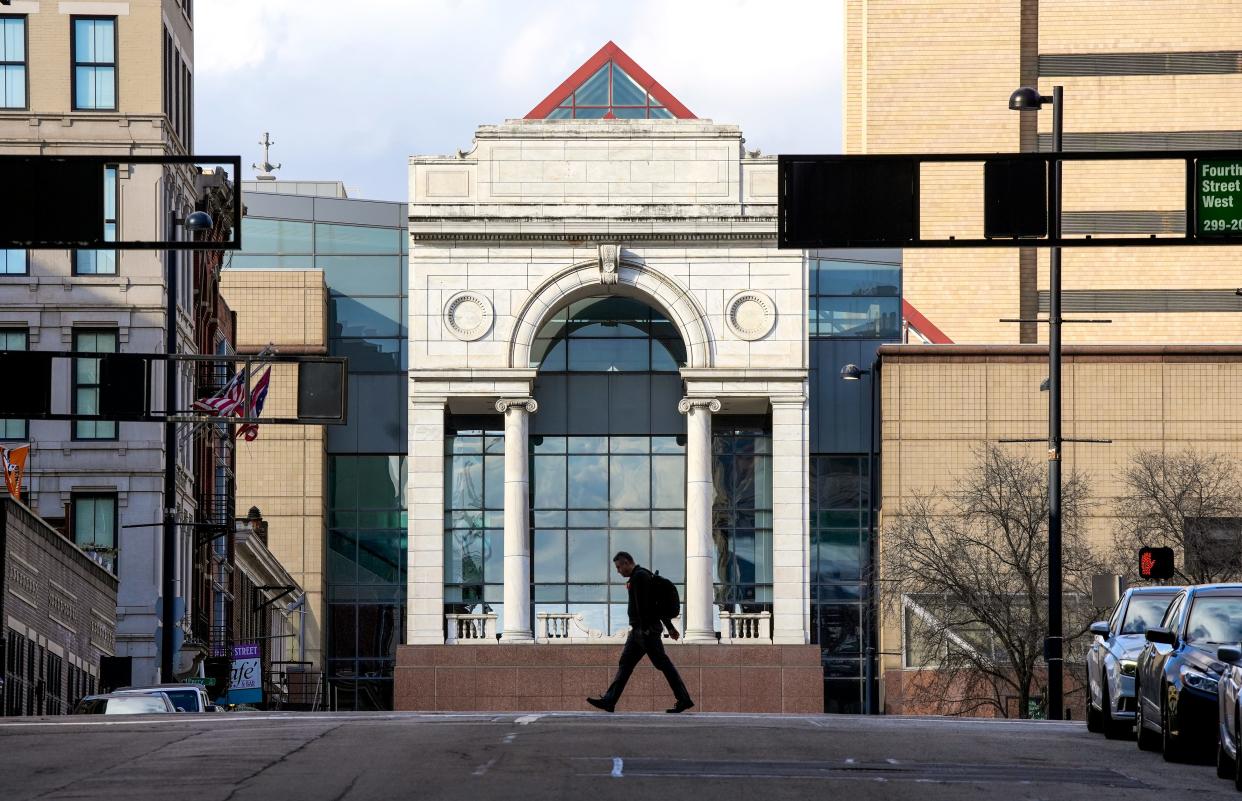
The historic Albee arch and most of the public art that punctuates the walls of the Duke Energy Convention Center will be permanently removed this summer.
Katie Westbrook, development director at the Cincinnati Center City Development Corp., also known as 3CDC, told The Enquirer that just two out of 12 pieces of art will be included in the 56-year-old building’s latest renovation. Only the “Space Walk” mural by Charley Harper inside the building and the Union Terminal mosaic murals by Winold Reiss that face Central Avenue will be part of the redevelopment when the convention center reopens in January 2026.
“We plan on treating each [piece] with the respect and dignity it deserves,” said Westbrook.
What to know: Cincinnati's Duke Energy Convention Center renovation
All other interior artwork will be saved and handed over to the city of Cincinnati, which owns everything, including the Albee arch, a mammoth remnant of the elegant Albee Theater. Ben Breuninger, spokesperson for City Manager Sheryl Long, said via email that the removed pieces will be stored at an unidentified city-owned property “until a reuse purpose is identified and funds are appropriated.”
The city will also pay for the removal, relocation and storage of the public art. Breuninger said some city agencies and other cultural institutions have expressed interest in housing the pieces permanently.
How will the Albee arch come down?
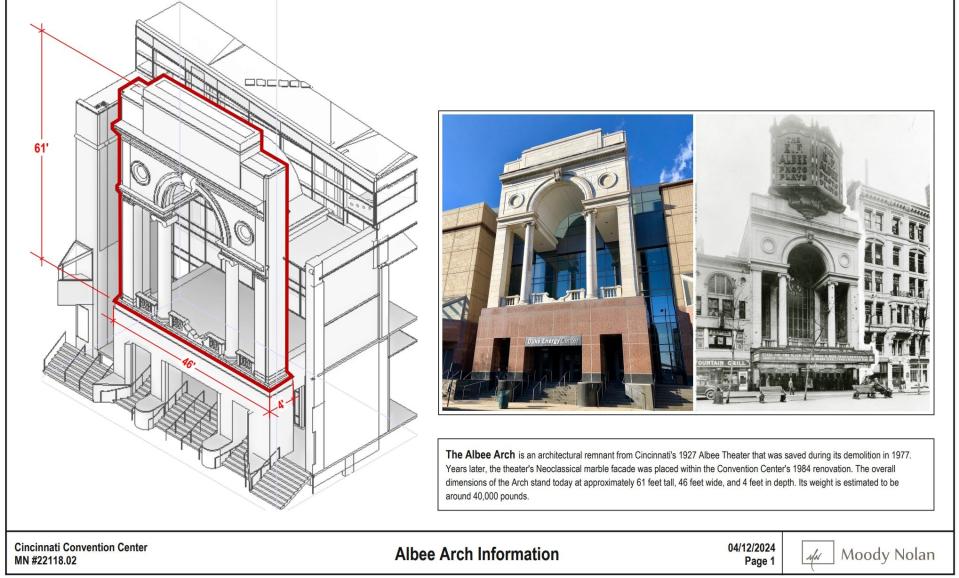
The Albee arch currently stands 61 feet tall at the Fifth and Plum streets entrance of the building. Made of marble, it’s estimated to weigh around 40,000 pounds.
Dismantling the Albee arch was always part of the plan, Westbrook admitted. “The history of the arch isn’t intertwined with the convention center, but it’s a structure that’s revered so it makes sense to save it.”
The Albee arch was incorporated into the major redesign of the convention center in 1986.
Beth Johnson, executive director of the Cincinnati Preservation Association, thinks that was a great solution at the time, but she believes the arch’s current location doesn’t do it justice.
Official renderings: Here's what the renovated Duke Energy Convention Center will officially look like
“I completely understand it not being part of the plan to keep it on the convention center,” she said. “People don’t know what it is and that section of Fifth Street isn’t a pedestrian-friendly environment ... It’s just kind of this piece of artwork that doesn't really match the rest of the building.”
Johnson thinks now is the ideal time to find a place Downtown that’s more fitting for the Albee arch such as around Fountain Square or in Smale Park.
“Removing the Albee Theater façade from the convention center façade allows the city of Cincinnati to find a location for the marble remnants where the beauty can be celebrated," Johnson said, "and hopefully to a location where people can once again travel through the arch to experience its impressive craftsmanship.”
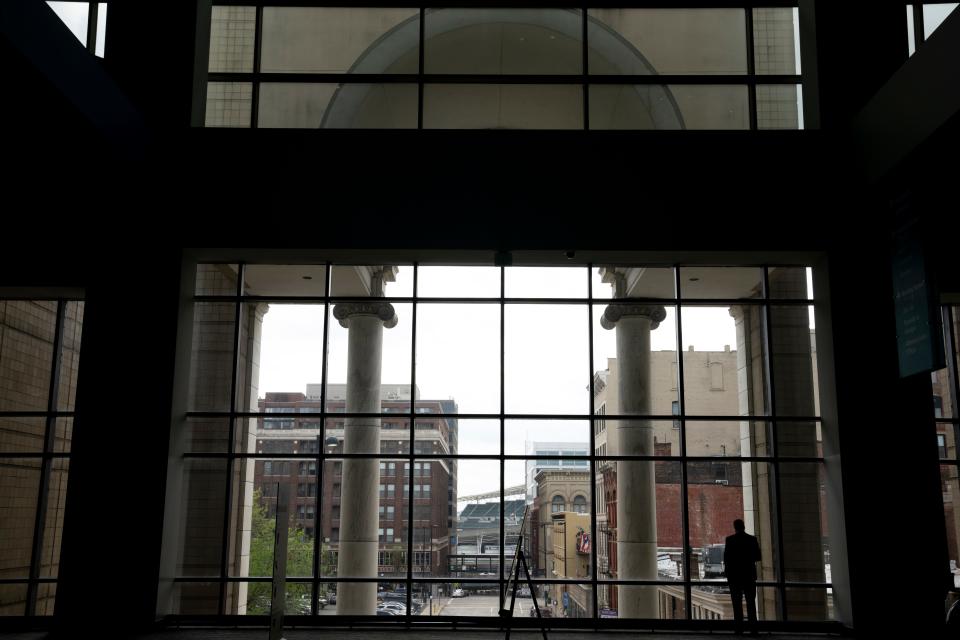
The four-story neoclassical marble arch was originally the memorable façade of the RKO Albee Theater, the fanciest of Cincinnati’s movie palaces. Designed by theater architect Thomas W. Lamb, the Albee opened on Christmas Eve 1927 during the late silent-movie era. The interior was even more majestic, decked out in marble with brass fixtures.
But urban renewal and the rise of suburban cineplexes spelled the end of the Downtown movie houses.
Located on Fifth Street opposite Fountain Square, the Albee was at a prime location for redevelopment in the 1970s. After efforts to preserve the Albee fell short, many of the fixtures were auctioned off and it was demolished in 1977.
During the demolition, workers carefully dismantled the arch and placed the pieces in a scrapyard beneath the Brent Spence Bridge until a location could be found to display it. It has been part of the convention center for the past 38 years.
Now, the Albee arch will go back into storage until a new home is determined.
Architect Moody Nolan’s $200 million design for the revamped convention center will feature glass walls and exterior metal cladding where the Albee arch, brick and red granite now stand.
3CDC is currently seeking a subcontractor to demolish the parts of the building that won’t be included in the redevelopment. The Albee arch will be removed piece by piece and packaged up so it can be put back together like a puzzle, Westbrook said. The arch is expected to come down later this year. The cost for its removal hasn’t been determined yet.
Reiss’s Union Terminal murals are staying
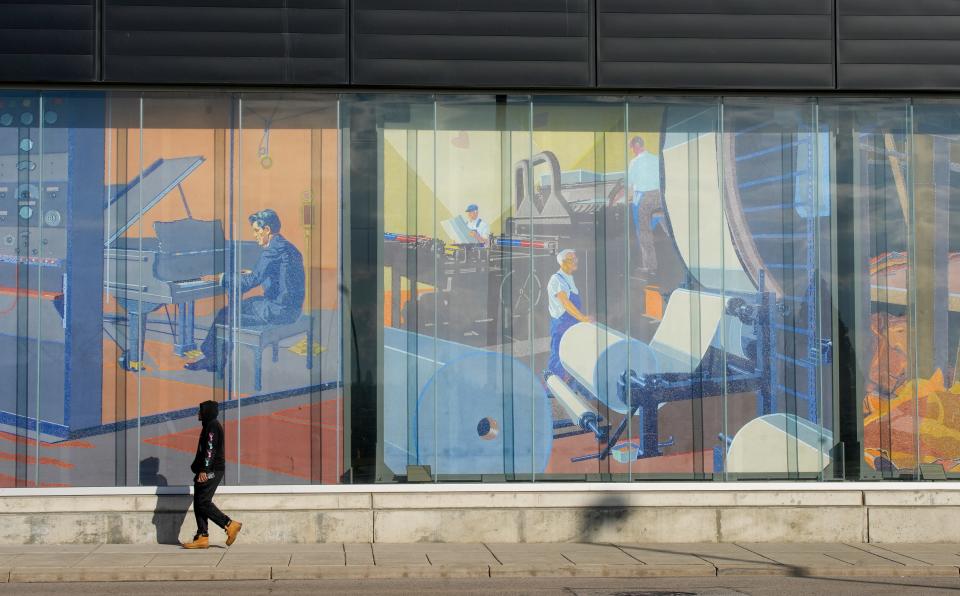
Winold Reiss’s famous Union Terminal mosaic murals are staying where they are. They have already been saved from the wrecking ball twice.
Original to the construction of Union Terminal in 1933, the murals by the German-born Art Deco artist depict many of Cincinnati’s prominent and historic industries, including Procter & Gamble, U.S. Playing Card, Kahn’s meats and Cincinnati Milling Machine.
When the Union Terminal concourse was demolished in 1974, preservationists rose up to save the artwork. Fourteen of the murals were saved, but the largest one, depicting a map of the United States, was destroyed.
The murals, measuring 20 feet by 20 feet and weighing 8 tons each, were loaded onto trucks and driven across the river to the terminals at the Cincinnati/Northern Kentucky International Airport.
When CVG closed two terminals in 2016, the city of Cincinnati got nine of the murals back. The Kenton County Airport Board paid $1.45 million to remove and transport the murals, and the city paid $750,000 for the cost of having them mounted.
“These murals capture the ambition, the innovation and the grit that makes Cincinnati what it is today,” then-City Manager Harry Black said in 2016 when they were unveiled on the western façade of the convention center.
And that is where they will stay.
‘The Hands that Built Our City’ will be torn down
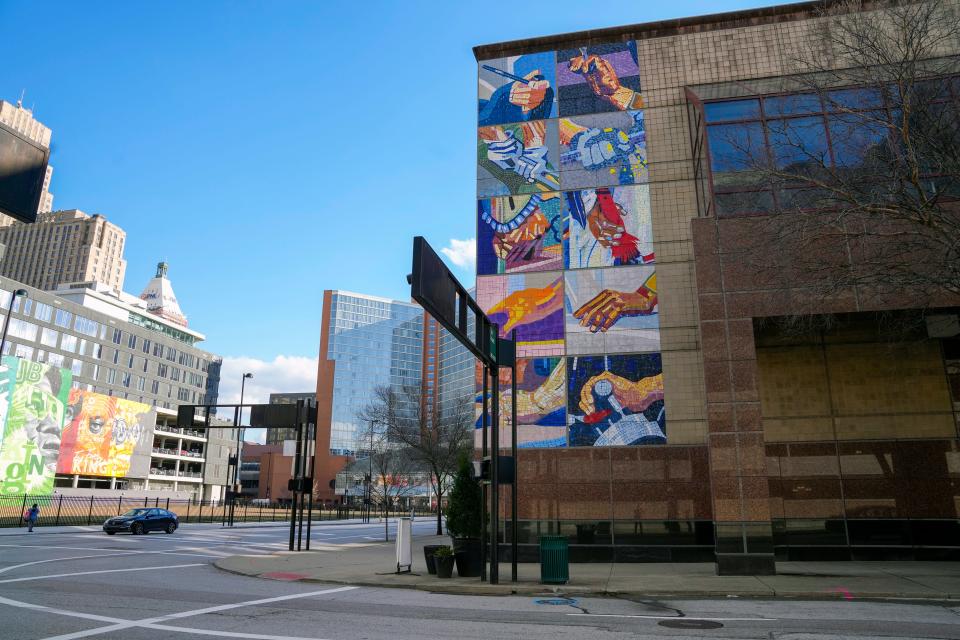
The colorful tile-like mural covering the corner of the convention center at Elm and Sixth streets won’t be preserved at all because it was painted directly onto the exterior wall.
Added to the building in 2013 by ArtWorks, “The Hands that Built Our City” highlights the hands of the workers found in Reiss’s famous industrial murals from Union Terminal. The mural was painted to look like real tile by ArtWorks designer Jenny Ustick and a team of 11 youth apprentices. New hands, including two convention center employees and one youth apprentice, were added to the collection of Reiss’s hands.
ArtWorks has partnered with the city for 15 years on convention center-related installations. Colleen Houston, CEO and artistic director, told The Enquirer that 100 artists and even more fabrication partners were employed to work on these projects during this time. “The vision had always been to celebrate local artists and create jobs for local artists,” she said. “The works are really special because they are inspired by the city itself.”
Houston aims to make recommendation to the city on where these pieces should be displayed in the future. “It’s our hope that the art is preserved and presented in similar public space that’s open and accessible to the community,” she said. “We’re anxious to have conversations with the city and see what that could look like.”
16.7 million color possibilities: Who picks what the Cincinnati icon sign looks like?
Which art pieces will be removed and preserved?
“Buds, Blossoms, Branches and Boughs for the Queen” by Brenda Tarbell
“Cincinnati Icons” by Sara Cormier
“Fluss” by Sandra Gross
“Humanity Outpost Marker” by Edward Casagrande
“Once Upon a River” by Tina Westerkamp
“Porkundstein” by Kim Shifflett
“Riverfront Rise” by Nicholas Moegly
“Roebling” by John and Marcia Koverman, Grace Masur and Abbey Smart
“Riverwaves” by Hayes Shanesy of Brush Factory
“Wall of Queens” by James Pate
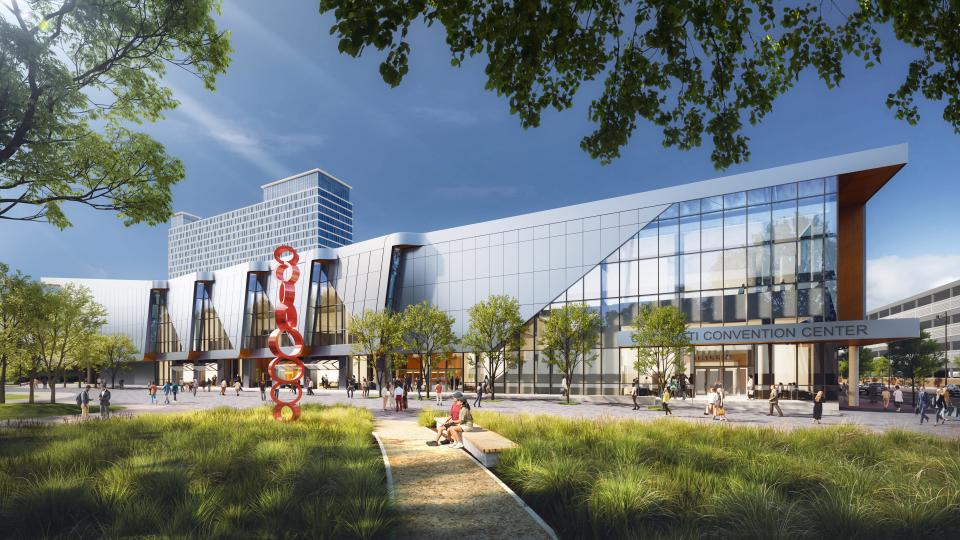
What about future art at the convention center?
Plans to bring new art into the renovated convention center haven’t been revealed, but it’s a priority, according to 3CDC. Whether or not the city and the nonprofit developer will partner with a local entity like ArtWorks remains to be seen.
“If you look at world-class convention centers across the country, they always have incredible art installations,” added ArtWorks’ Houston.
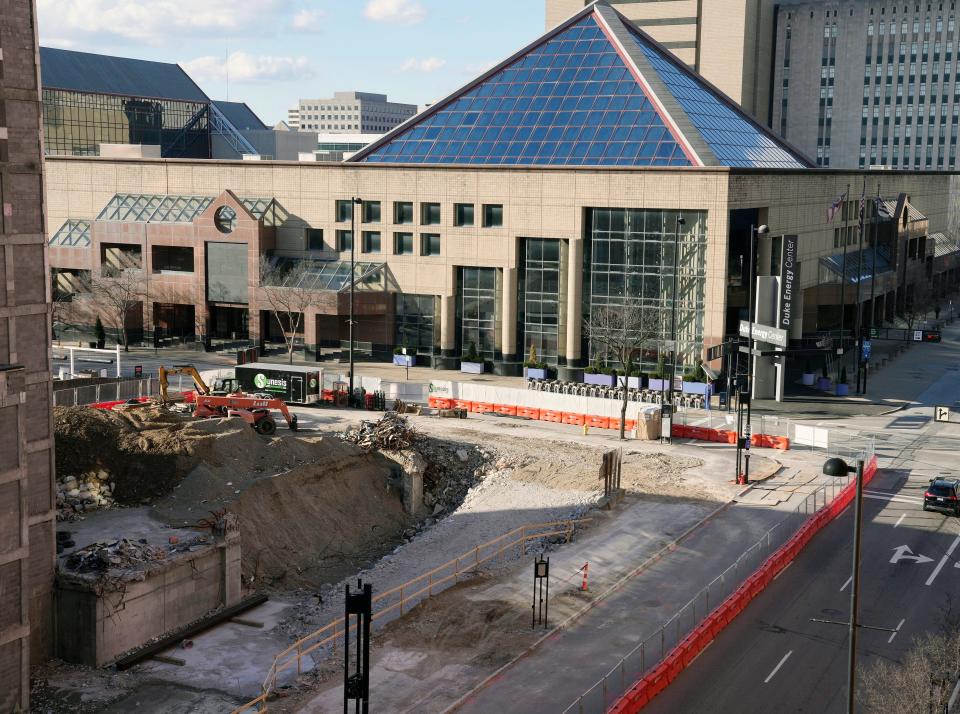
This article originally appeared on Cincinnati Enquirer: Albee arch, historic murals: What will be in new convention center?

